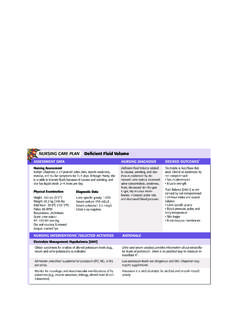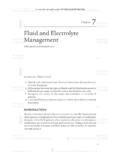Transcription of Potassium Disorders: Hypokalemia and Hyperkalemia
1 Potassium disorders : Hypokalemia and Hyperkalemia ANTHONY J. VIERA, MD, MPH, and NOAH WOUK, MD, University of North Carolina at Chapel Hill School of Medicine, Chapel Hill, North Carolina Hypokalemia and Hyperkalemia are common electrolyte disorders caused by changes in Potassium intake, altered excretion, or transcellular shifts. Diuretic use and gastrointestinal losses are common causes of Hypokalemia , whereas kidney disease, hyperglycemia, and medication use are common causes of Hyperkalemia . When severe, Potassium disorders can lead to life-threatening cardiac conduction disturbances and neuromuscular dysfunction. Therefore, a first priority is determining the need for urgent treatment through a combination of history, physical examination, laboratory, and electrocardiography findings.
2 Indications for urgent treatment include severe or symptomatic hypo- kalemia or Hyperkalemia ; abrupt changes in Potassium levels; electrocardiography changes; or the presence of certain comorbid conditions. Hypokalemia is treated with oral or intravenous Potassium . To prevent cardiac conduction dis- turbances, intravenous calcium is administered to patients with hyperkalemic electrocardiography changes. Insulin, usually with concomitant glucose, and albuterol are preferred to lower serum Potassium levels in the acute setting;. sodium polystyrene sulfonate is reserved for subacute treatment. For both disorders , it is important to consider poten- tial causes of transcellular shifts because patients are at increased risk of rebound Potassium disturbances.
3 (Am Fam Physician. 2015;92(6):487-495. Copyright 2015 American Academy of Family Physicians.). P. More online otassium disorders are common. same dosage, chlorthalidone is more likely to at http://www. Hypokalemia (serum Potassium induce Hypokalemia than hydrochlorothia- level less than mEq per L [ zide, which is more often implicated because CME This clinical content mmol per L]) occurs in up to 21% of its widespread ,12 Diuretic-induced conforms to AAFP criteria for continuing medical of hospitalized patients and 2% to 3% of Hypokalemia is dose-dependent and tends to education (CME). See Hyperkalemia (serum potas- be mild (3 to mEq per L [3 to mmol CME Quiz Questions on sium level more than 5 mEq per L [5 mmol per L]), although it can be more severe when page 441.)]
4 Per L] in adults, more than mEq per L accompanied by other causes ( , gastroin- Author disclosure: No rel- [ mmol per L] in children, and more than testinal [GI] losses).13. evant financial affiliations. 6 mEq per L [6 mmol per L] in neonates). GI LOSSES. Patient information: occurs in up to 10% of hospitalized patients A handout on this topic, and approximately 1% of ,5 The GI losses are another common cause of written by the authors of this article, is available body's plasma Potassium concentration is Hypokalemia , particularly among hospital- at closely regulated by a variety of mechanisms. ized The mechanism by which afp/2015/0915/p487-s1.
5 Upper GI losses induce Hypokalemia is indi- html. Causes of Hypokalemia rect and stems from the kidney's response to Hypokalemia results from abnormal losses, the associated alkalosis. As a portion of daily transcellular shifts, or insufficient intake Potassium is excreted in the colon, lower (Table 1).6-8 Abnormal losses are most com- GI losses in the form of persistent diarrhea Because the kidney can significantly can also result in Hypokalemia and may be lower Potassium excretion in response to accompanied by hyperchloremic decreased intake, insufficient intake is rarely the sole cause of Hypokalemia , but it often contrib- Evaluation and Management utes to Hypokalemia in hospitalized of Hypokalemia GENERAL PRINCIPLES.
6 RENAL LOSSES Hypokalemia is often asymptomatic. Evalu- Diuretic use is a common cause of renally ation begins with a search for warning signs mediated When given in the or symptoms warranting urgent treatment September Downloaded15, 2015. from Volume 92, Number 6. the American Family Physician website at American Academy of Family Copyright 2015 American Family Physicians. For thePhysician 487. private, noncom- mercial use of one individual user of the website. All other rights reserved. Contact for copyright questions and/or permission requests. Potassium disorders Table 1. Causes of Hypokalemia Abnormal losses Transcellular shifts Medications (continued).
7 (Figure 1).7,14 These include weakness or pal- Diuretics Alkalosis pitations, changes on electrocardiography Laxatives and enemas Refeeding syndrome (ECG), severe Hypokalemia (less than Corticosteroids Increased beta2 adrenergic stimulation mEq per L [ mmol per L]), rapid-onset Gastrointestinal losses Delirium tremens Hypokalemia , or underlying heart disease Renal losses Head injury or ,15 Most cases of Hypokalemia - Osmotic diuresis Myocardial ischemia induced rhythm disturbances occur in Mineralocorticoid excess Thyrotoxicosis individuals with underlying heart Types I and II renal tubular acidosis Familial hypokalemic periodic Early identification of transcellular shifts is Polydipsia paralysis important because management may differ.
8 Intrinsic renal transport defects Hypothermia Identification and treatment of concurrent Hypomagnesemia Inadequate intake hypomagnesemia are also important because Dialysis/plasmapheresis Anorexia magnesium depletion impedes Potassium Transcellular shifts Dementia Medications repletion and can exacerbate Hypokalemia - Starvation Insulin overdose induced rhythm ,17 Total parenteral nutrition Beta2 sympathomimetics Pseudohypokalemia HISTORY AND PHYSICAL EXAMINATION Decongestants Delayed sample analysis Xanthines A focused history includes evaluation for Significant leukocytosis Amphotericin B (> 75,000 cells per mm3. possible GI losses, review of medications, Verapamil intoxication [ 109 per L]).
9 And assessment for underlying cardiac Chloroquine (Aralen) intoxication comorbidities. A history of paralysis, hyper- Barium intoxication thyroidism, or use of insulin or beta agonists Cesium intoxication suggests possible transcellular shifts leading to redistributive Hypokalemia . The physical NOTE: Listed in approximate order of frequency. examination should focus on identifying Information from references 6 through 8. cardiac arrhythmias and neurologic mani- festations, which range from generalized weakness to ascending paralysis. arrhythmias increases as serum Potassium concentra- tion decreases, these findings are not reliable because LABORATORY ANALYSIS AND ECG some patients with severe Hypokalemia do not have The diagnosis should be confirmed with a repeat serum ECG Potassium measurement.
10 Other laboratory tests include serum glucose and magnesium levels, urine electrolyte Treatment of Hypokalemia and creatinine levels, and acid-base balance. The most The immediate goal of treatment is the prevention of accurate method for evaluating urinary Potassium excre- potentially life-threatening cardiac conduction distur- tion is a 24-hour timed urine Potassium collection; nor- bances and neuromuscular dysfunction by raising serum mal kidneys excrete no more than 15 to 30 mEq per L Potassium to a safe level. Further replenishment can pro- (15 to 30 mmol per L) of Potassium per day in response to ceed more slowly, and attention can turn to the diagnosis Hypokalemia .













